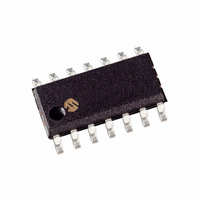PIC16F506-I/SL Microchip Technology, PIC16F506-I/SL Datasheet - Page 73

PIC16F506-I/SL
Manufacturer Part Number
PIC16F506-I/SL
Description
IC PIC MCU FLASH 1KX14 14SOIC
Manufacturer
Microchip Technology
Series
PIC® 16Fr
Datasheets
1.PIC12F510-ISN.pdf
(124 pages)
2.PIC16F506-ISL.pdf
(12 pages)
3.PIC16F506-ISL.pdf
(8 pages)
4.PIC16F506-ISL.pdf
(22 pages)
5.PIC16F506-IP.pdf
(114 pages)
Specifications of PIC16F506-I/SL
Program Memory Type
FLASH
Program Memory Size
1.5KB (1K x 12)
Package / Case
14-SOIC (3.9mm Width), 14-SOL
Core Processor
PIC
Core Size
8-Bit
Speed
20MHz
Peripherals
POR, WDT
Number Of I /o
11
Ram Size
67 x 8
Voltage - Supply (vcc/vdd)
2 V ~ 5.5 V
Data Converters
A/D 4x8b
Oscillator Type
Internal
Operating Temperature
-40°C ~ 85°C
Processor Series
PIC16F
Core
PIC
Data Bus Width
8 bit
Data Ram Size
67 B
Maximum Clock Frequency
20 MHz
Number Of Programmable I/os
12
Number Of Timers
1
Maximum Operating Temperature
+ 85 C
Mounting Style
SMD/SMT
3rd Party Development Tools
52715-96, 52716-328, 52717-734
Development Tools By Supplier
PG164130, DV164035, DV244005, DV164005, PG164120, ICE2000
Minimum Operating Temperature
- 40 C
On-chip Adc
3-ch x 8-bit
Lead Free Status / RoHS Status
Lead free / RoHS Compliant
Eeprom Size
-
Connectivity
-
Lead Free Status / Rohs Status
Lead free / RoHS Compliant
Available stocks
Company
Part Number
Manufacturer
Quantity
Price
Company:
Part Number:
PIC16F506-I/SL
Manufacturer:
MICROCHIP
Quantity:
16 700
Company:
Part Number:
PIC16F506-I/SL
Manufacturer:
Microchip Technology
Quantity:
33 360
Part Number:
PIC16F506-I/SL
Manufacturer:
MICROCHIP/微芯
Quantity:
20 000
11.0
The PIC16 instruction set is highly orthogonal and is
comprised of three basic categories.
• Byte-oriented operations
• Bit-oriented operations
• Literal and control operations
Each PIC16 instruction is a 12-bit word divided into an
opcode, which specifies the instruction type, and one
or more operands which further specify the operation
of the instruction. The formats for each of the catego-
ries is presented in Figure 11-1, while the various
opcode fields are summarized in Table 11-1.
For byte-oriented instructions, ‘f’ represents a file
register designator and ‘d’ represents a destination
designator. The file register designator specifies which
file register is to be used by the instruction.
The destination designator specifies where the result of
the operation is to be placed. If ‘d’ is ‘0’, the result is
placed in the W register. If ‘d’ is ‘1’, the result is placed
in the file register specified in the instruction.
For bit-oriented instructions, ‘b’ represents a bit field
designator which selects the number of the bits
affected by the operation, while ‘f’ represents the
number of the file in which the bit is located.
For literal and control operations, ‘k’ represents an
8 or 9-bit constant or literal value.
TABLE 11-1:
© 2007 Microchip Technology Inc.
italics User defined term (font is courier)
[
(
Field
WDT
label
TOS
dest
< >
PC
TO
PD
→
W
∈
b
k
x
d
f
]
)
INSTRUCTION SET SUMMARY
Register file address (0x00 to 0x7F)
Working register (accumulator)
Bit address within an 8-bit file register
Literal field, constant data or label
Don’t care location (= 0 or 1)
The assembler will generate code with x = 0. It is the
recommended form of use for compatibility with all
Microchip software tools.
Destination select;
d = 0 (store result in W)
d = 1 (store result in file register ‘f’)
Default is d = 1
Label name
Top-of-Stack
Program Counter
Watchdog Timer counter
Time-out bit
Power-down bit
Destination, either the W register or the specified
register file location
Options
Contents
Assigned to
Register bit field
In the set of
OPCODE FIELD
DESCRIPTIONS
Description
All instructions are executed within a single instruction
cycle, unless a conditional test is true or the program
counter is changed as a result of an instruction. In this
case, the execution takes two instruction cycles. One
instruction cycle consists of four oscillator periods.
Thus, for an oscillator frequency of 4 MHz, the normal
instruction execution time is 1 μs. If a conditional test is
true or the program counter is changed as a result of an
instruction, the instruction execution time is 2 μs.
Figure 11-1 shows the three general formats that the
instructions can have. All examples in the figure use
the following format to represent a hexadecimal
number:
where ‘h’ signifies a hexadecimal digit.
FIGURE 11-1:
Byte-oriented file register operations
Bit-oriented file register operations
Literal and control operations (except GOTO)
Literal and control operations – GOTO instruction
0xhhh
11
11
11
11
PIC12F510/16F506
d = 0 for destination W
d = 1 for destination f
f = 5-bit file register address
b = 3-bit bit address
f = 5-bit file register address
k = 8-bit immediate value
k = 9-bit immediate value
OPCODE
OPCODE
OPCODE
OPCODE
6
8 7
GENERAL FORMAT FOR
INSTRUCTIONS
b (BIT #)
d
5
9
8
4
8
7
5 4
f (FILE #)
k (literal)
k (literal)
f (FILE #)
DS41268D-page 71
0
0
0
0


















